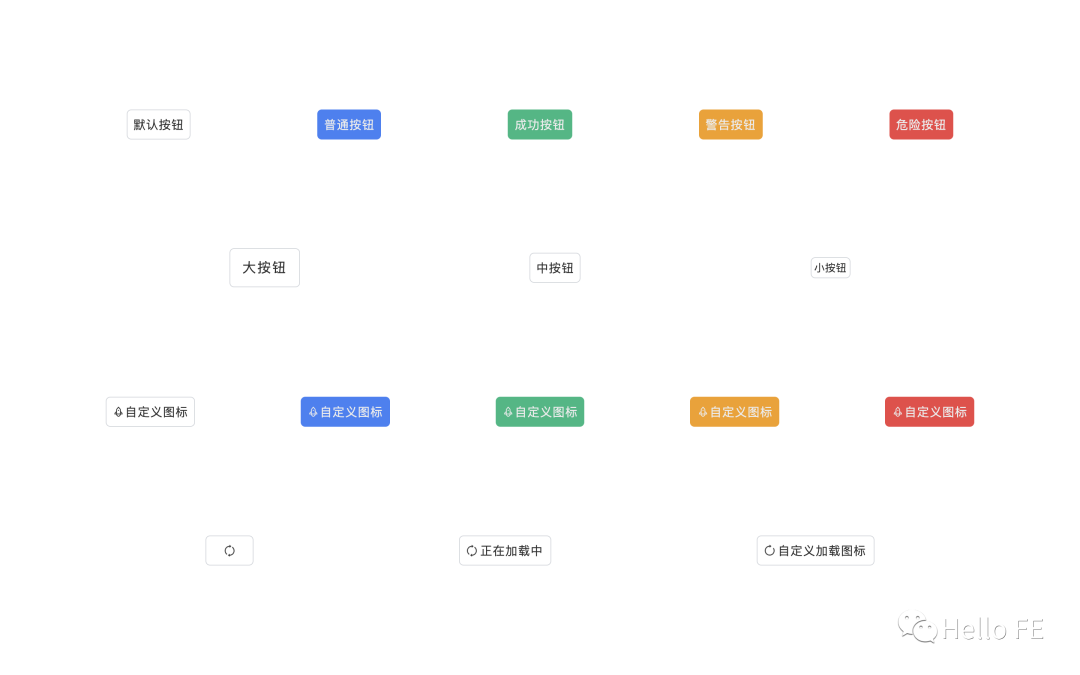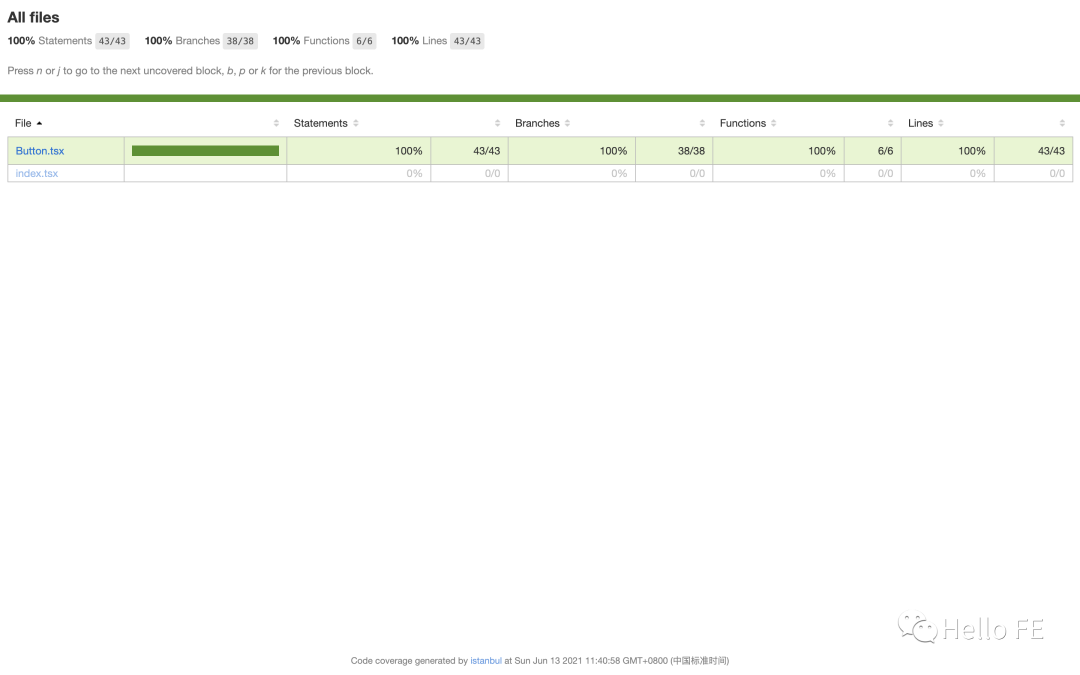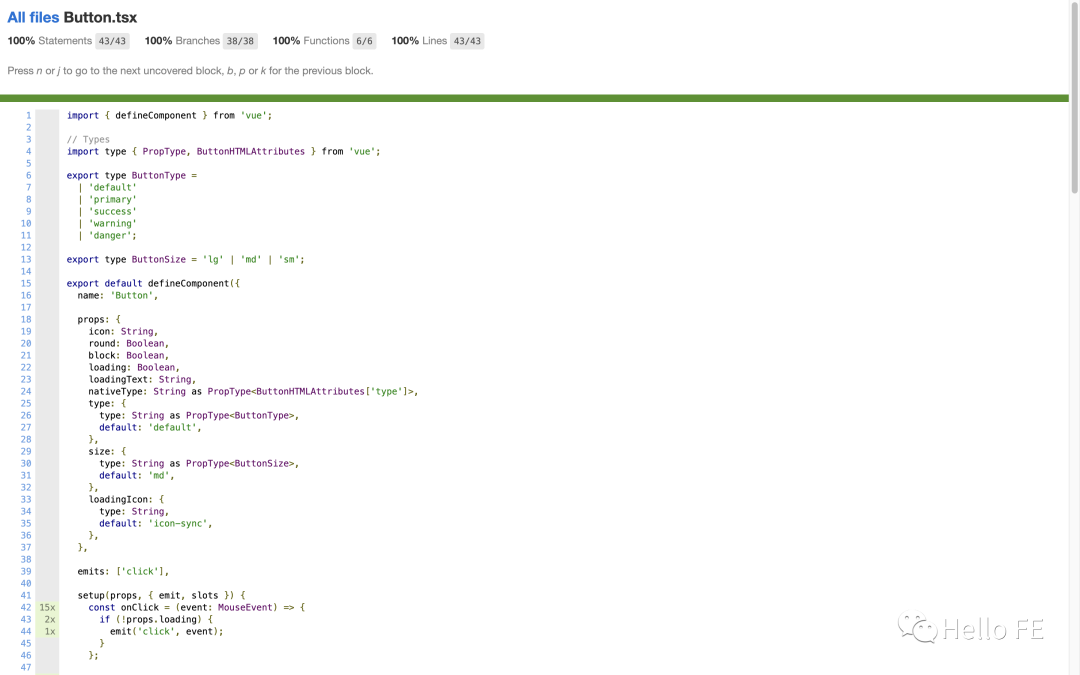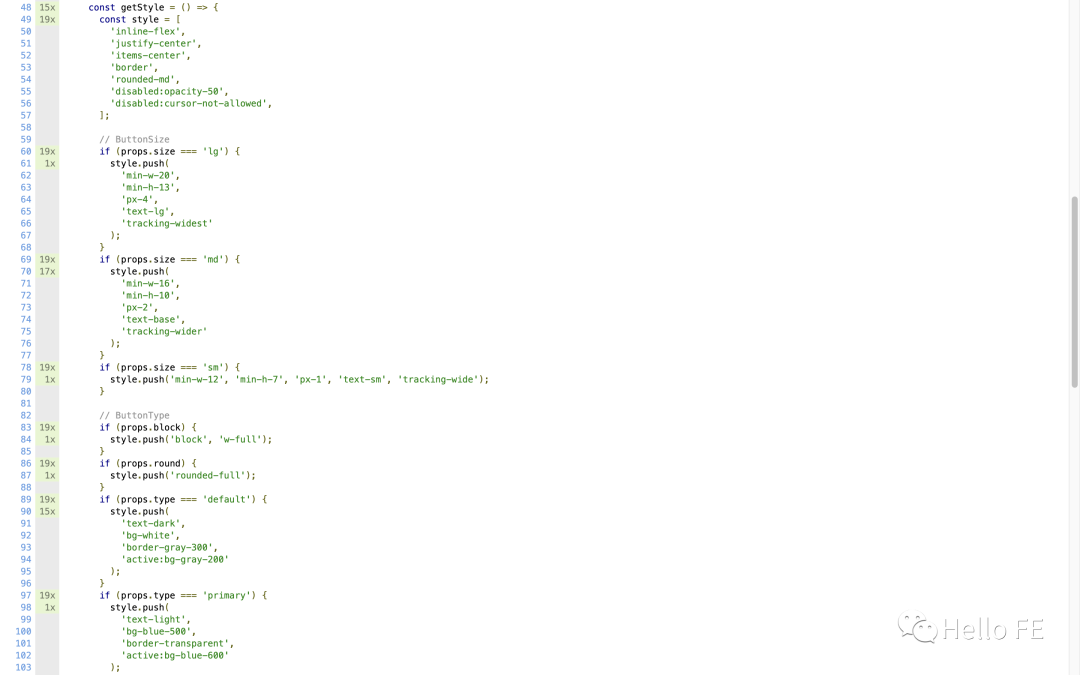一文搞定前端自动化测试(Vue 实战)
本文首发于公众号 「Hello FE」,关注获取更多内容
前言
距离上一次更新自动化测试相关的内容已经过去大半年了,之前写了基础篇和 React 实战,说好了要更新 Vue 实战的。
毕业设计、论文、答辩都结束了,难得有一段属于自己的时间,就决定更新一下。
这次通过实现一个 Button 组件并完善其测试用例带大家学习 Vue 中的自动化测试。
前面两篇还没学习过的同学,建议先学习前面的内容再来看这一篇文章:
试试前端自动化测试!(基础篇)[1] 试试前端自动化测试!(React 实战)[2]
本文中所有代码都存放在此仓库:Learning-Vue-Test[3]
本文中实现的
Button组件在此处可以预览:Learning-Vue-Test[4]
创建项目
首先需要创建一个项目来开始我们的自动化测试实战,这里选用了 `Vite`[5] 作为构建工具来创建项目,用 @vitejs/app 创建一个 vue-ts 项目。
为什么选 Vite 呢?因为我参与了 Vite 的官方中文文档的翻译。 因为 Vite 又快又好用。
当然,也可以选择使用 Vue CLI 创建项目,创建项目的时候勾选 TypeScript 和 Unit Test,并且选择 Jest 作为单元测试工具就行。
环境配置
如果选用的是 Vue CLI 创建项目的话,就可以跳过这一步了,@vue/cli-plugin-unit-jest 已经将基本的测试环境配置都预设好了,只需要对 JSX 做一下支持就可以了。
如果是 Vite 的话,就需要做比较多的配置了,首先是安装一些依赖:
npm install jest@next @types/jest @vue/test-utils@next jest-transform-stub vue-jest@next babel-jest@next @babel/preset-env @babel/preset-typescript @vue/babel-plugin-jsx @vitejs/plugin-vue-jsx windicss vite-plugin-windicss @testing-library/jest-dom -D
依赖很多,看晕了是吧?没关系,一个一个来介绍:
jest:提供单元测试能力。@vue/test-utils:对Vue组件进行测试(Vue官方提供)。jest-transform-stub:将非JavaScript文件转换为Jest可执行的JavaScript代码。vue-jest:将Vue SFC(单文件组件)转换为Jest可执行的JavaScript代码。babel-jest:将非标准JavaScript代码(JSX/TSX)转换为Jest可执行的JavaScript代码。@babel/preset-env:提供测试时最新的JavaScript语法的Babel Preset。@babel/preset-typescript:提供测试时TypeScript语法的Babel Preset。@vue/babel-plugin-jsx:提供测试时在Vue中使用JSX/TSX语法的Babel Plugin。@vitejs/plugin-vue-jsx:提供开发时在Vue中使用JSX/TSX语法的Vite Plugin。windicss:Windi CSS核心依赖。vite-plugin-windicss:提供开发时在Vue中使用Windi CSS能力的Vite Plugin。@testing-library/jest-dom:提供测试时部分与DOM相关的断言。
需要安装的依赖就这些,依赖安装好之后,就需要编写相应的配置文件了。
vite.config.ts
Vite 的配置就不详细介绍了,直接复制粘贴就行,主要是一个路径别名的配置和插件配置:
import { defineConfig } from 'vite';
import path from 'path';
import Vue from '@vitejs/plugin-vue';
import VueJSX from '@vitejs/plugin-vue-jsx';
import WindiCSS from 'vite-plugin-windicss';
// https://vitejs.dev/config/
export default defineConfig({
resolve: {
alias: {
'@': path.resolve(__dirname, 'src'),
},
},
plugins: [
Vue(),
VueJSX({
optimize: true,
}),
WindiCSS(),
],
});
windi.config.ts
比较懒,不想自己写样式,决定使用 Windi CSS 做样式开发。
实测很爽,只用调整 class 就能实现样式,开发调试体验都很棒。
具体的配置直接复制粘贴就行,主要对颜色做了一点拓展,增加了 light 和 dark 两种颜色:
import { defineConfig } from 'vite-plugin-windicss';
export default defineConfig({
extract: {
include: ['index.html', 'src/**/*.{vue,jsx,tsx,html}'],
},
theme: {
extend: {
colors: {
dark: '#303030',
light: '#ebebeb',
},
},
},
});
extract.include 数组中的文件就是 Windi CSS 生效的文件,对 index.html 和所有 src 目录下的 Vue/JSX/TSX/HTML 文件生效。
详细的用法可以到 `Windi CSS` 官方文档[6]中学习。
package.json
要跑测试用例,就需要给 package.json 中加入一条新的 npm script:
{
...
"scripts": {
"dev": "vite",
"build": "vue-tsc --noEmit && vite build",
"serve": "vite preview",
"test:watch": "jest --watch --coverage"
},
...
}
在 jest 后加上 --watch 和 --coverage 两个参数是为了开启监听和测试覆盖率报告,这样在每次写完测试脚本后保存,Jest 就会自动跑一轮测试脚本并给出测试覆盖率报告。
加入了这一条 test:watch 后,就可以在终端里使用 npm run test:watch 启动测试脚本了。
jest.config.js
等一下!输入 npm run test:watch 之后报错了对不对?因为还没有对 Jest 做配置。
在项目的根目录下创建一个 jest.config.js 的文件,然后复制粘贴这段配置:
module.exports = {
roots: ['<rootDir>/src'],
testEnvironment: 'jsdom',
collectCoverageFrom: [
'src/components/**/*.{js,jsx,ts,tsx}',
'!src/components/**/*.d.ts',
],
setupFilesAfterEnv: ['<rootDir>/src/setupTests.ts'],
testMatch: [
'<rootDir>/src/**/__tests__/**/*.{js,jsx,ts,tsx}',
'<rootDir>/src/**/*.{spec,test}.{js,jsx,ts,tsx}',
],
moduleFileExtensions: [
'js',
'jsx',
'ts',
'tsx',
'json',
// tell Jest to handle *.vue files
'vue',
],
transform: {
// process *.vue files with vue-jest
'.+\\.(css|styl|less|sass|scss|jpg|jpeg|png|svg|gif|eot|otf|webp|ttf|woff|woff2|mp4|webm|wav|mp3|m4a|aac|oga)$':
'jest-transform-stub',
'^.+\\.vue$': 'vue-jest',
'^.+\\.(j|t)sx?$': 'babel-jest',
},
transformIgnorePatterns: [
'[/\\\\]node_modules[/\\\\].+\\.(js|jsx|mjs|cjs|ts|tsx)$',
'^.+\\.module\\.(css|sass|scss)$',
],
moduleNameMapper: {
'^@/(.*)$': '<rootDir>/src/$1',
},
};
配置很多比较复杂,在上一期的详细的内容里有一部分的讲解,这里主要对一些核心的配置讲解一下,详细的内容可以到 `Jest`[7] 官方文档里学习。
testEnvironment:用于指定测试运行的环境,默认是node,因为测试的是运行在浏览器中的代码,所以要改成jsdom。上一篇React实战里用的是jest-environment-jsdom-fourteen,现在由于Jest已经内置了JSDOM,所以已经不需要使用上一篇里用到的库了。collectCoverageFrom:用于指定测试覆盖率收集的文件,只有在这个列表里的文件的测试覆盖率才会被统计。setupFilesAfterEnv:用于为测试环境做预设,例如引入一些与DOM相关的断言。testMatch:用于指定测试文件,只有在这个列表里的文件才会被当成测试脚本。moduleFileExtensions:用于指定模块文件类型,只有在列表里的文件类型才能被识别。transform:用于指定对应类型的文件转换器,这里非JavaScript/TypeScript/Vue文件使用了jest-transform-stub进行转换,而Vue则使用vue-jest,JS/JSX/TS/TSX使用babel-jest转换。transformIgnorePatterns:用于指定文件转换器需要忽略的文件。moduleNameMapper:用于设置引入时路径的别名,这里设置引入路径是@开头的模块都到src目录下查找。
此处的配置参考的是 @vue/plugin-unit-jest 中 typescript-and-babel 的 preset,稍微做了一些改动,将 TS 文件的处理由 ts-jest 改成了 babel-jest,将其交给 Babel 来处理。(实测交给 Babel 来处理比原来快约 60%,猜测原因在于 Babel 对 TS 做编译时会去掉类型信息跳过类型校验)
babel.config.js
对 Jest 配置之后,还需要对 Babel 做配置,不然当 Jest 将对应的文件交给 Babel 处理的时候会报错。
因此需要在根目录下创建 babel.config.js,往里面写入 Babel 配置:
module.exports = {
presets: [
'@babel/preset-typescript',
['@babel/preset-env', { targets: { node: 'current' } }],
],
plugins: [
[
'@vue/babel-plugin-jsx',
{
optimize: true,
},
],
],
};
细心的读者应该发现了,明明在 Vite 里已经配置了 JSX/TSX 支持,为什么在 Babel 里面还要使用插件?
因为 Vite 中的插件只在 development 和 production 环境下生效,在 test 环境下完全由 Jest 来跑测试用例,而遇到 JSX/TSX 会交给 babel-jest 来做转换,如果没有使用插件 Jest 就无法识别 JSX/TSX 语法。
至于配置的这两个 preset 在前面已经介绍过了,就不重复介绍了。
index.html
因为组件里用到了一些 icon,所以需要引入 iconfont 的字体资源,直接复制粘贴到 index.html 的 head 标签里面就可以了:
<link
rel="stylesheet"
href="https://at.alicdn.com/t/font_2595498_06e66vrjx514.css?spm=a313x.7781069.1998910419.63&file=font_2595498_06e66vrjx514.css"
/>
对应 icon 的 class 可以到 iconfont 官网中的官方图标库里找到Ant Design 官方图标库[8],查看对应图标的 class。
编写组件
配置文件真多,真麻烦,好在都可以复制粘贴。
现在就开始创建一个组件,真正开始写代码!
首先先删除项目中 src/components 目录下的 HelloWorld.vue,再打开 App.vue,将与 HelloWorld.vue 的内容都删除。
完成第一步之后就可以开始创建 Button 组件的代码了,在 src/components 目录下创建一个 Button.tsx,开始写组件。
写组件的内容不是本篇文章的重点,就简单贴个代码,放个效果:
import { defineComponent } from 'vue';
// Types
import type { PropType, ButtonHTMLAttributes } from 'vue';
export type ButtonType =
| 'default'
| 'primary'
| 'success'
| 'warning'
| 'danger';
export type ButtonSize = 'lg' | 'md' | 'sm';
export default defineComponent({
name: 'Button',
props: {
icon: String,
round: Boolean,
block: Boolean,
loading: Boolean,
loadingText: String,
nativeType: String as PropType<ButtonHTMLAttributes['type']>,
type: {
type: String as PropType<ButtonType>,
default: 'default',
},
size: {
type: String as PropType<ButtonSize>,
default: 'md',
},
loadingIcon: {
type: String,
default: 'icon-sync',
},
},
emits: ['click'],
setup(props, { emit, slots }) {
const onClick = (event: MouseEvent) => {
if (!props.loading) {
emit('click', event);
}
};
const getStyle = () => {
const style = [
'inline-flex',
'justify-center',
'items-center',
'border',
'rounded-md',
'disabled:opacity-50',
'disabled:cursor-not-allowed',
];
// ButtonSize
if (props.size === 'lg') {
style.push(
'min-w-20',
'min-h-13',
'px-4',
'text-lg',
'tracking-widest'
);
}
if (props.size === 'md') {
style.push(
'min-w-16',
'min-h-10',
'px-2',
'text-base',
'tracking-wider'
);
}
if (props.size === 'sm') {
style.push('min-w-12', 'min-h-7', 'px-1', 'text-sm', 'tracking-wide');
}
// ButtonType
if (props.block) {
style.push('block', 'w-full');
}
if (props.round) {
style.push('rounded-full');
}
if (props.type === 'default') {
style.push(
'text-dark',
'bg-white',
'border-gray-300',
'active:bg-gray-200'
);
}
if (props.type === 'primary') {
style.push(
'text-light',
'bg-blue-500',
'border-transparent',
'active:bg-blue-600'
);
}
if (props.type === 'success') {
style.push(
'text-light',
'bg-green-500',
'border-transparent',
'active:bg-green-600'
);
}
if (props.type === 'warning') {
style.push(
'text-light',
'bg-yellow-500',
'border-transparent',
'active:bg-yellow-600'
);
}
if (props.type === 'danger') {
style.push(
'text-light',
'bg-red-500',
'border-transparent',
'active:bg-red-600'
);
}
return style;
};
const renderIcon = () => {
if (props.loading) {
return slots.loadingIcon ? (
slots.loadingIcon()
) : (
<i
class={[
'iconfont',
'inline-block',
'animate-spin',
props.loadingIcon,
]}
/>
);
}
if (props.icon) {
return <i class={['iconfont', 'inline-block', props.icon]} />;
}
if (slots.icon) {
return slots.icon();
}
};
const renderText = () => {
if (props.loading) {
if (slots.loadingText) {
return slots.loadingText();
}
if (props.loadingText) {
return <span class="mx-0.5">{props.loadingText}</span>;
}
}
if (slots.default) {
return slots.default();
}
};
return () => (
<button class={getStyle()} onClick={onClick}>
{renderIcon()}
{renderText()}
</button>
);
},
});
预览之前,要改一改 App.vue,直接复制粘贴一下就行:
<template>
<div class="w-screen h-screen flex flex-col justify-evenly">
<div class="flex justify-evenly items-center">
<Button>默认按钮</Button>
<Button type="primary">普通按钮</Button>
<Button type="success">成功按钮</Button>
<Button type="warning">警告按钮</Button>
<Button type="danger">危险按钮</Button>
</div>
<div class="flex justify-evenly items-center">
<Button size="lg">大按钮</Button>
<Button>中按钮</Button>
<Button size="sm">小按钮</Button>
</div>
<div class="flex justify-evenly items-center">
<Button icon="icon-rocket">自定义图标</Button>
<Button type="primary" icon="icon-rocket">自定义图标</Button>
<Button type="success" icon="icon-rocket">自定义图标</Button>
<Button type="warning" icon="icon-rocket">自定义图标</Button>
<Button type="danger" icon="icon-rocket">自定义图标</Button>
</div>
<div class="flex justify-evenly items-center">
<Button :loading="true" />
<Button :loading="true" loadingText="正在加载中" />
<Button
:loading="true"
loadingText="自定义加载图标"
loadingIcon="icon-reload"
/>
</div>
</div>
</template>
<script lang="ts">
import { defineComponent } from 'vue';
import Button from '@/components/Button';
export default defineComponent({
name: 'App',
components: {
Button,
},
});
</script>
最终实现的效果是这样的:

看完代码之后,是不是觉得用 Windi CSS 写组件库也挺爽的?
编写测试用例
组件写好了,人工测试好像也没啥问题啊,为啥还要写测试用例呢?
而且这里还没采用 TDD 的思想,先写测试用例再写代码,为什么呢?
人工测试当然没问题,组件能正常运行,也没发现什么问题,但是万一以后要重构呢?或者人工测试不够完美,没覆盖到所有分支呢?这就需要用自动化测试的脚本和测试覆盖率报告来约束了。
至于为什么没用 TDD,先写测试用例再写代码,是因为我本人抽象能力还不够,还没有炼成在编码之前就抽象出组件的输入输出的能力,就只能边写边看,再测试了。(太菜了)
现在就来一起写测试用例!
引入工具
要做组件的测试就一定要有对应的工具对组件进行渲染,并能够调用一些 API 来触发一些事件。
这里就采用 Vue 官方提供的 Vue Test Utils(VTU) 来测试。
与 Button 同级的目录下创建一个 Button.test.tsx,引入 VTU 和 Button 组件:
import { shallowMount } from '@vue/test-utils';
import Button from './Button';
事实上 VTU 为我们提供了两种渲染组件的方法(shallowMount/mount),这里引入的时候选择的是 shallowMount 而不是 mount,因为在 Button 中,除了 HTML 标签外不存在其他组件,即 Button 组件内没有包含子组件,所以直接使用 shallowMount。
shallowMount 和 mount 两者的渲染行为是有差异的,前者只会渲染当前组件,子组件的内容不会被渲染,而后者会将整个组件树都渲染出来。
关于两者渲染行为的差异,可以查看这篇文章:Difference between mount and shallowMount in Vue Test Utils[9]
建议在能使用 shallowMount 的情况下优先使用 shallowMount,能有效提高跑测试用例的速度。
事件分发
Button 组件最重要功能当然是 click,所以一定要对 click 事件做测试,组件内部一定要能够向外分发 click 事件,对应的测试用例:
it('should emit click event.', async () => {
const wrapper = shallowMount(Button);
await wrapper.trigger('click');
expect(wrapper.emitted('click')).toBeDefined();
});
VTU 渲染组件后会返回一个组件的 wrapper 实例,通过调用 wrapper 上的方法和属性能够实现一些能力,上面调用 wrapper.trigger('click') 就是触发组件的 click 事件。
然后在断言里,需要判断组件是否有向外分发 click 事件。通过 wrapper.emitted('click') 能够获取到组件是否向外分发了 click 事件,如果有则 wrapper.emitted('click') 的值不为 undefined,就可以断言其是 toBeDefined 的。
当然,这段测试用例也有坑,那就是只知道组件向外分发了 click 事件,但是不知道分发了几次,所以也有需要改的地方。wrapper.emitted 的返回值是 Event[] | undefined,因此可以改成:
it('should emit click event.', async () => {
const wrapper = shallowMount(Button);
await wrapper.trigger('click');
// expect(wrapper.emitted('click')).toBeDefined();
expect(wrapper.emitted('click')).toHaveLength(1);
});
Button 组件肯定有被 disabled 的时候,这个时候组件是不可用的,也就是说不能向外分发 click 事件,对应的测试用例:
it('should not emit click event when disabled.', async () => {
const wrapper = shallowMount(Button, {
props: {
disabled: true,
},
});
await wrapper.trigger('click');
expect(wrapper.emitted('click')).toBeUndefined();
});
同样的,当 Button 组件处于 loading 状态的时候,也不能向外分发 click 事件,对应的测试用例:
it('should not emit click event when loading.', async () => {
const wrapper = shallowMount(Button, {
props: {
loading: true,
},
});
await wrapper.trigger('click');
expect(wrapper.emitted('click')).toBeUndefined();
});
组件渲染
事件分发测试完了之后,就需要测试组件渲染的部分了。
测试渲染通常会用到快照测试,将组件以快照的形式保存下来,一方面能够直观地看到渲染结果,另一方面当渲染结果发生变化是能够得到提醒,查看渲染结果的变动内容。
测试组件渲染的时候也需要转变一下思路,因为组件是使用 Windi CSS 来实现样式的,所以测试渲染是否正常只需要找到对应的元素,判断 class 上是否有需要的样式即可。
因为使用了 iconfont 的 Font class,所以测试起来也很方便。
后面的测试用例,都在测试组件渲染并生成快照,直接贴代码:
it('should render icon correctly.', async () => {
const wrapper = shallowMount(Button, {
props: {
icon: 'icon-rocket',
},
});
expect(wrapper.find('.icon-sync').exists()).toBeFalsy();
expect(wrapper.find('.icon-rocket').exists()).toBeTruthy();
expect(wrapper.html()).toMatchSnapshot();
await wrapper.setProps({ loading: true });
expect(wrapper.find('.icon-sync').exists()).toBeTruthy();
expect(wrapper.find('.icon-rocket').exists()).toBeFalsy();
expect(wrapper.html()).toMatchSnapshot();
});
it('should render text correctly.', async () => {
const wrapper = shallowMount(Button, {
props: {
loadingText: 'Custom Loading',
},
slots: {
default: () => <span>Custom Text</span>,
},
});
expect(wrapper.find('span').exists()).toBeTruthy();
expect(wrapper.find('span').element).toHaveTextContent(/custom text/gi);
expect(wrapper.find('.icon-sync').exists()).toBeFalsy();
expect(wrapper.html()).toMatchSnapshot();
await wrapper.setProps({ loading: true });
expect(wrapper.find('span').exists()).toBeTruthy();
expect(wrapper.find('span').element).toHaveTextContent(/custom loading/gi);
expect(wrapper.find('.icon-sync').exists()).toBeTruthy();
expect(wrapper.html()).toMatchSnapshot();
});
it('should render icon slot correctly.', async () => {
const wrapper = shallowMount(Button, {
slots: {
icon: () => <i class="iconfont icon-rocket" />,
},
});
expect(wrapper.find('.icon-sync').exists()).toBeFalsy();
expect(wrapper.find('.icon-rocket').exists()).toBeTruthy();
expect(wrapper.html()).toMatchSnapshot();
await wrapper.setProps({ loading: true });
expect(wrapper.find('.icon-sync').exists()).toBeTruthy();
expect(wrapper.find('.icon-rocket').exists()).toBeFalsy();
expect(wrapper.html()).toMatchSnapshot();
});
it('should render loading slot correctly.', async () => {
const wrapper = shallowMount(Button, {
slots: {
loadingIcon: () => <i class="iconfont icon-reload" />,
loadingText: () => <span>Custom Loading</span>,
},
});
expect(wrapper.find('.icon-reload').exists()).toBeFalsy();
expect(wrapper.find('span').exists()).toBeFalsy();
expect(wrapper.html()).toMatchSnapshot();
await wrapper.setProps({ loading: true });
expect(wrapper.find('.icon-reload').exists()).toBeTruthy();
expect(wrapper.find('span').element).toHaveTextContent(/custom loading/gi);
expect(wrapper.html()).toMatchSnapshot();
});
it('should render small button correctly.', () => {
const wrapper = shallowMount(Button, {
props: {
size: 'sm',
},
});
expect(wrapper.html()).toMatchSnapshot();
});
it('should render large button correctly.', () => {
const wrapper = shallowMount(Button, {
props: {
size: 'lg',
},
});
expect(wrapper.html()).toMatchSnapshot();
});
it('should render primary button correctly.', () => {
const wrapper = shallowMount(Button, {
props: {
type: 'primary',
},
});
expect(wrapper.element).toHaveClass('bg-blue-500');
expect(wrapper.html()).toMatchSnapshot();
});
it('should render success button correctly.', () => {
const wrapper = shallowMount(Button, {
props: {
type: 'success',
},
});
expect(wrapper.element).toHaveClass('bg-green-500');
expect(wrapper.html()).toMatchSnapshot();
});
it('should render warning button correctly.', () => {
const wrapper = shallowMount(Button, {
props: {
type: 'warning',
},
});
expect(wrapper.element).toHaveClass('bg-yellow-500');
expect(wrapper.html()).toMatchSnapshot();
});
it('should render danger button correctly.', () => {
const wrapper = shallowMount(Button, {
props: {
type: 'danger',
},
});
expect(wrapper.element).toHaveClass('bg-red-500');
expect(wrapper.html()).toMatchSnapshot();
});
it('should render block button correctly.', () => {
const wrapper = shallowMount(Button, {
props: {
block: true,
},
});
expect(wrapper.element).toHaveClass('block');
expect(wrapper.html()).toMatchSnapshot();
});
it('should render round button correctly.', () => {
const wrapper = shallowMount(Button, {
props: {
round: true,
},
});
expect(wrapper.element).toHaveClass('rounded-full');
expect(wrapper.html()).toMatchSnapshot();
});
简单介绍一下几个方法:
wrapper.find('span').exists()返回一个boolean,用于判断span标签是否存在,find方法的参数是一个选择器,可以是id选择器,也可以是class选择器等等。wrapper.find('span').element返回一个DOM,用于获取span标签对应的DOM,也可以获取其他任何满足选择器条件的DOM。wrapper.html()返回一个HTML字符串,用于生成组件快照。toBeTruthy/toBeFalsy用于断言结果为真值/假值。toHaveTextContent用于断言当前元素是否有匹配的textContent,参数为string | RegExp。toMatchSnapshot用于断言当前组件快照是否与上一次的组件快照相同,如果没有组件快照则会创建。
查看测试覆盖率
按照上面的测试用例跑一轮,测试覆盖率肯定是 100% 的,这是在简单组件上测试才有这样的效果。
事实上在实际应用当中,测试覆盖率很难达到 100%,能够达到百分之八九十就已经是很高的覆盖率了。
在上面的 test:watch script 里加了 --coverage,Jest 就会在根目录下生成一个 coverage 文件夹,将里面的 clover.xml 使用浏览器打开就能够查看测试覆盖的详情了。
页面效果像这样:

点击 Button.tsx 还能看到组件代码被测试的详细情况,例如某个分支被测试的次数以及未被测试到的分支:


总结
在写这篇文章的同时我也在不断学习和思考,深感自身代码功底还不够。
尤其是在写组件的时候完全不能抽象出组件的输入输出,导致没有办法先写测试用例再写组件。
希望这篇文章能给和我一样在不断学习的同学一些帮助!
参考资料
Jest 是一个令人愉快的 JavaScript 测试框架,专注于简洁明快。| Jest[10] 下一代前端开发与构建工具 | Vite[11] Next generation utility-first CSS framework. | Windi CSS[12] @vue/cli-plugin-unit-jest | Haoqun Jiang[13] Difference between mount and shallowMount in Vue test utils | Sai gowtham[14] 轻量、可靠的移动端 Vue 组件库 | Vant[15]
参考资料
试试前端自动化测试!(基础篇): https://juejin.cn/post/6844904194600599560
[2]试试前端自动化测试!(React 实战): https://juejin.cn/post/6894234532224958478
[3]Learning-Vue-Test: https://github.com/wjq990112/Learning-Vue-Test
[4]Learning-Vue-Test: https://learning-vue-test.vercel.app/
[5]Vite: https://cn.vitejs.dev/
Windi CSS 官方文档: https://cn.windicss.org/guide/
Jest: https://jestjs.io/
Ant Design 官方图标库: https://www.iconfont.cn/collections/detail?spm=a313x.7781069.1998910419.d9df05512&cid=9402
[9]Difference between mount and shallowMount in Vue Test Utils: https://reactgo.com/vue-testing-mount-vs-shallowmount/
[10]Jest 是一个令人愉快的 JavaScript 测试框架,专注于简洁明快。| Jest: https://jestjs.io/zh-Hans/
[11]下一代前端开发与构建工具 | Vite: https://cn.vitejs.dev/
[12]Next generation utility-first CSS framework. | Windi CSS: https://cn.windicss.org/guide/
[13]@vue/cli-plugin-unit-jest | Haoqun Jiang: https://github.com/vuejs/vue-cli/tree/dev/packages/@vue/cli-plugin-unit-jest#readme
[14]Difference between mount and shallowMount in Vue test utils | Sai gowtham: https://reactgo.com/vue-testing-mount-vs-shallowmount/
[15]轻量、可靠的移动端 Vue 组件库 | Vant: https://vant-contrib.gitee.io/vant/v3/#/zh-CN/home
